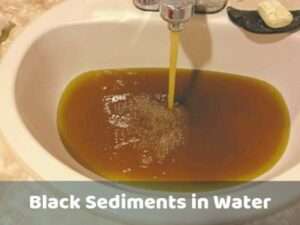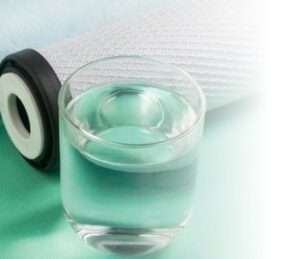If you observe black sediments in your well water, it indicates the presence of manganese, a soluble solid. The reason why these sediments are visible to the naked eye is due to the oxidation process.
Similarly, the presence of brownish-orange sediments is a sign of ferric iron in your water. Iron and manganese are often found together in groundwater, but the levels of manganese are usually lower than those of iron.
While these minerals may appear colorless initially, exposure to oxygen can cause a color change, resulting in orange-brown for iron and black for manganese.
In this post, we will cover:
- What causes well water to have black sediments?
- Main causes of black sediments in well water.
- Effects of black sediments in well water.
- Effective methods to remove black sediment from well water.
What causes well water to have black sediments?
The presence of black sediments in well water is a prevalent occurrence in households that rely on private wells for domestic purposes, primarily due to the widespread availability and cost-effectiveness of well water.
If you are considering removing these minerals from your water, it is likely that your intention is more focused on aesthetics rather than medicinal purposes.
Iron and manganese are vital minerals required by the human body, albeit in small amounts. They belong to the class of essential minerals known as trace minerals.
Despite their significance to the body, some individuals may prefer not to consume them, particularly in drinking water, owing to the unappealing metallic taste that these minerals impart to water, which is generally undesirable to both humans and animals.
What causes the water in a well to turn dark brown?

Manganese and iron, essential minerals for human health, are prevalently found in natural sources such as deep wells and springs, where water has undergone prolonged contact with rock formations.
Nonetheless, these minerals can also be introduced into water systems via deep and surface coal mining activities, leading to the formation of black sediment in water sources.
Notably, Pennsylvania has been identified as a location with a significant presence of these minerals in wells and springs. According to a comprehensive study conducted by Penn State, approximately 17% of private water supply sources sampled across the state demonstrated excessive iron levels.
The northern and western regions of the state are particularly prone to such mineral accumulation.
Overall, it is crucial to assess water sources for potential manganese and iron contamination, as high levels of these minerals can pose serious health risks if consumed regularly.
Black Specks in Water and Their Effects
Residents in these specific areas may have a firsthand understanding of the extent of water contamination. The presence of black specks can lead to plumbing obstructions and a shortened lifespan for plumbing appliances like washing machines, water heaters, and pressure tanks.
Furthermore, a distinct metallic taste and discoloration on utensils may be observed in drinking water.
To tackle this issue effectively, it is recommended that individuals conduct a preliminary investigation into known water concerns in their locality through the EPA (Environmental Protection Agency) and analyze the concentration levels of their well water.
Additionally, an independent water test is advised, as water previously considered safe may now pose a risk due to changes in EPA standards.
A general mineral analysis should provide a list of common minerals. Remember, through analysis, the following items are important to test for:
- Ph.
- Hardness
- Iron
- Manganese
- Total Dissolved Solids
Iron and manganese are common elements found in drinking water that can cause discoloration and stains in sinks and linen. Iron typically causes orange or brown stains, while manganese can result in dense or solid black stains.
To ensure safe consumption, the recommended concentration of iron in drinking water is less than 0.3 mg/L, and less than 0.05 mg/L for manganese.
The United States Environmental Protection Agency (EPA) has established a health advisory of 0.3 mg/L for manganese due to concerns about its potential neurological health effects when regularly consumed above this level.
It is important to note that a health advisory is a non-enforceable standard designed to inform consumers about possible health risks associated with drinking water.
Effective Methods to Remove Black Particles from Well Water
There exist a range of treatment techniques available for proficiently eliminating iron and manganese from water, which are contingent on the specific form and concentration of these metals. By utilizing these approaches, the removal process can be accomplished with efficacy.
Water Testing

When analyzing water, it is necessary to determine the form of iron and manganese and the precise concentration of each of these metals.
The form of the metals in the water could be referred to as dissolved or reduced if the well water is initially clear but changes to orange-brown or black when exposed to oxygen.
In this case, they have dissolved salts; due to oxidation, their respective precipitates are formed.
Reduced iron and manganese levels are most widespread in groundwater with a pH of less than 7.0.
Sometimes the solid particles of metals are immediately visible in the well or source water, in which case the metals are already in their oxidized form. This is common in water sources with a higher pH (>7.0) or where oxygen is readily available in water, for example, in shallow source waters.
Knowing the metal concentration determines which water treatment options are more cost-effective and practical to solve the problem.
Iron and manganese are common pollutants in water and can be detected in many commercial laboratories. To carry out a comprehensive treatment plan, it is advisable to have it thoroughly tested in a certified DEP laboratory.
Read:- 5 Top Well Water Test Kit
Once you have determined the concentration level of your well water, it’s time to remove these minerals.
Ion Exchange
The initial step in eliminating iron and manganese from water is to intercept them at the point of entry (POE) before the water is utilized. This can be achieved by employing softening agents that facilitate ion exchange. Specifically, sodium ions substitute iron and manganese ions during the process of ion exchange.
By using backwashing and regeneration, the resin bed in the water softener effectively removes the manganese and iron from the water.
The efficacy of the water softener depends on several factors, such as water pH, concentration, and hardness.
Water softeners are typically recommended when the water’s pH level is above 6.7, and the water’s hardness ranges from 3 to 20 grains per gallon (50 – 350 mg/L), with iron and manganese levels lower than 5 mg/L.
In instances where the levels of iron and manganese exceed the recommended limit, it’s recommended to use a sediment water filter instead.
In this case, the well’s raw water should not come into contact with air and chlorine, as they are oxidizing agents that can cause damage to the softening resin during frequent backwashing.
Recommended:
Sediment Filters for Well Water
Poly-phosphate Addition
This treatment approach is optimal for water with iron concentrations below 2 mg/L. However, it is not effective in eliminating manganese.
Phosphate is introduced into the water via a chemical feed pump, and the dosage is carefully adjusted to achieve the desired result. This process is akin to a syringe injection and results in the sequestration of iron, as phosphate encapsulates it and prevents it from being entirely removed from the water.
One issue with this method is that iron sequestration can cause the water to taste metallic, affecting its overall flavor. Additionally, excessive phosphate usage can lead to slippery water and cause diarrhea in consumers.
Furthermore, poly-phosphate may degrade in the water heater, which could result in the release of sequestered iron.
Oxidizing filters

A more professional and refined way to describe the process of removing iron and manganese from water would be as follows:
The use of polyphosphate as a treatment method for removing iron and manganese from water has limitations, and therefore, an alternative approach is necessary. A more effective solution involves the use of oxidizing filters, which oxidize iron and manganese before they are filtered out.
The filter media is treated with potassium permanganate, which forms a coating that enables the oxidation of reduced iron and manganese, ultimately allowing them to be filtered from the water. This method eliminates the need for ion exchange, as it filters the raw water directly.
However, it should be noted that maintaining manganese green filters requires careful attention, including frequent regeneration with a potassium permanganate solution, as it is consumed during the oxidation of dissolved metals. Regular backwashing is also necessary to remove oxidized iron and manganese particles.
Furthermore, the potassium permanganate solution used for regeneration is highly toxic and must be handled with care and stored in accordance with specific safety measures.
Manganese green filters are effective for moderate levels of dissolved and oxidized manganese and iron, with the frequency of reverse washing and regeneration increasing as the concentration of metals increases. It is recommended that these filters be used when the concentration of iron and manganese is between 3 and 10 mg/L.
Birm filters, which are similar to manganese greensand filters, do not require regeneration as they use oxygen in the raw water to oxidize metals. However, the raw water must contain a certain amount of dissolved oxygen, and the pH must be at least 6.8 for iron removal and 7.5 for manganese removal.
Despite these requirements, the efficacy of manganese removal varies for birm filters, and regular backwashing is necessary to remove oxidized metal particles that build up.
Overall, the process of removing iron and manganese from water through oxidation and filtration is highly effective when properly maintained, and is recommended for moderate levels of dissolved and oxidized manganese and iron.
So, what is the deal-breaker?
When the concentrations of iron and manganese exceed 10 mg/L, the most effective treatment method involves the process of oxidizing the dissolved metals into their solid forms.
This is achieved through the use of oxidizing agents such as chlorine (the most commonly used), potassium permanganate, and hydrogen peroxide.
To ensure that the oxidizing agent is properly fed into the water, a chemical feed pump is employed to deliver a sodium hypochlorite solution upstream of a mixing tank or plastic hose coil. The mixing tank or plastic hose must allow for adequate contact time to form iron and manganese precipitates.
To eliminate the taste and unpleasant odors of residual chlorine, it may be necessary to install an activated carbon filter. It is important to note that chlorine may not be the best oxidizing agent for manganese due to its low pH; a substantially high-pH oxidant is required for complete oxidation.
Regular maintenance is crucial in ensuring the effectiveness of this treatment method. Solution tanks must be consistently filled, and mechanical filters washed to remove accumulated iron and manganese particles. Carbon filters must be replaced when they have run out.
The maintenance schedule should be primarily based on the concentration of metals in the raw water and the volume of water used. Adherence to these maintenance procedures is essential in achieving optimal results.
Iron and Manganese Filters for Well Water
What Type Of Sediment/Particles Do I Have In My Water System?
Sediments refer to the solid particles that settle at the bottom of a water container. These particles originate from diverse sources and can take various forms, including mineral deposits. Groundwater is particularly susceptible to sedimentation.
To identify the specific type of sediment in your water system, a comprehensive water analysis is necessary. The analysis should encompass parameters such as pH, water hardness (calcium carbonate), total dissolved solids, as well as the application of oxidants to observe potential sediment precipitation.
Employing these methods will enable you to establish the exact nature of sediment present in your water source.
1. What is the Effective Method To Use To Eliminate All Black Sediments From My Domestic Water?
Oxidation and filtration or other methods that combine both processes. This is due to the fact that soluble solids cannot be filtered out, and insoluble solids cannot be oxidized out either.
A combination of both processes results in higher quality results for filtered water.
2. Can I Only Depend On Certified Accredited Lab Testing Or Are There Alternative Means?
Accredited laboratory tests should be the best option. However, water testing extends far beyond the sediment removal procedure.
If you plan to use the sediment removal procedure at home, you may want to buy a home test kit and follow the steps very concisely.
Conclusion
Small amounts of manganese are common, and water levels rise. Along with other minerals such as iron and calcium, these can be deposited into the aquifer.
Since well water is derived from soil, you should expect bacteria, lead, arsenic, chromium-6, mercury, manganese, radon and other volatile organic compounds (VOCs) to be present in your water.
Needless to say, if you want to get rid of those contaminants, you will need a well-water sedimentation filter.
Recommended:- Are Sediment Filter Worthy It
What to do if your well water has black sediments
1. If black sediment in water is accompanied by poor taste and unpleasant odour, water testing is necessary to determine the level of contaminants in drinking water.
From our perspective, you may want to test the well water for iron, silica, bacteria, hardness and manganese. You can also visit the website of your local health department or the State Department for a certified lab inspection.
2. In a situation where you find dark brown rocks or sand particles when you pull water out of your tap. It may be that your well pump is well below the established standard, or a minimum of fifteen to twenty feet high from the bottom of the well.
You can fix this problem by lifting up the pump shaft, increasing the distance between the pump shaft and the well base.
3. Another source of black sediment in well water may be worn off on the wall box. (The housing is a doubled PVC plastic, placed inside the well wall, which allows water to enter through and simultaneously keep out of mud and sand. )
Over time, the enclosure display gadgets then enable is sedimentation of silt, and sand to enter the well. It is recommended that you contact a well driller for confirmation.
Why Do I need a sediment filter for Black Sediments?
Safer than faucet water. The sediment filter allows you to get the most from your water without contaminants and sediments. They are approved by the FDA’s regulatory board and are excellent at what they do. Safer compared to bottled water.
Bottled water to a certain extent is not large, despite the fact that they provide purified water. The FDA’s regulatory council are unable to apply strict measures on them so your tap water is safe as bottled water.
Sees the elimination of large sediments and bacteria in water. Sediment filters are used to remove sediment of any size. The materials used for elimination make it more efficient in the work.
- Easy installation of the sediment filters: The filters in the sediment filter are easy to install because they come with a manual on how to proceed with the entire process. Most of the filters can be attached easily to the faucets.
- Environmental-friendly: The sediment filter will reduce the need to buy bottled water. This will eliminate the use of plastic bottles and therefore reduce plastic disposal in the environment.
- Less expensive: It is with respect to the water bottle that you may need to buy from time to time. The sediment filter will remove the need to buy the water bottle since clean water will be readily available at no additional cost.
When should I replace my sediment filter?
Replacement of the sediment filter should take place between three and six months. After that time, the filter may not function effectively and the presence of black sediments may be noticed in your water once again.
Changing the filter will allow the sediment filter to work efficiently and remove all contaminants.
How do I test a sediment filter?
A sediment filter should be capable of removing turbidity in water that causes water cloudiness.
The cloudy aspect of water is caused by the suspension of particles in water and can cause a color change. Sediment water filters are not capable of removing chemical substances, heavy metals, bacteria or dissolved solids from water.
As a result, there will be no improvement in the taste of the water or odor.
Sediment filters are critical components of water treatment systems and remove all dirt and fine particles from the water, followed by chemical treatment.
Why do I have dirt in my well water?
Broken hoses are the most frequent cause of dirty well water. Broken pipes permit dirt in the well water that can bring smell, bad taste, and dirt in your water.
Mineral deposits are an additional cause of dirt in your well water. They leave behind sedimentary residues and dirt in the well water. Screening and cleaning may help with disposal.
High levels of iron are commonplace in well water. The iron leaves behind red patches and installing a filtration system will be the solution.
Organic matter is another source of fouling in your well water. Organic substances can stain clothing in black or yellow.
Chlorine usage can solve this problem immediately. A binary aqueous compound that occurs at room temperature in the form of clear, colourless, odourless, tasteless liquid. freezes in ice below 0 degrees centigrade and ends above 100 degrees centigrade; widely used as a solvent plus (Definitions, synonyms, translation)
Recommended
Submersible Well Pump for Domestic Use
Do you need a shower filter if you have well water?